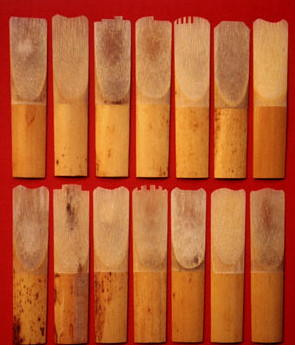If you look at the sax reeds in this picture closely, you will note that each is cut or notched, altered in some fashion so as to render them difficult to play. Play them – or at least some of them – the James Fei Alto Saxophone Quartet did last Tuesday at the Rotunda in
The Taiwanese-born Fei, who looks at least a decade younger than his 34 years, brought his quartet to town to recreate the extraordinary works gathered together on James Fei Alto Quartets, the most recent CD from Fei’s Organized Sound label. Altered quartets is the way my mind wants to rework that title. Fei, who spends as much time working with live electronics as he does on his various saxophones, approaches the sax much the same way that Jimi Hendrix once approached the electric guitar or Cecil Taylor approaches the piano, which is to say that any aspect of the instrument might be employed to make sound, from “crippled” reeds (Fei’s word choice) to moisture in the horn’s bell, to playing so very shrill that the audience doesn’t so much hear the music as it does feel it, literally standing those microscopic hairs of the inner ear on end – simply cup a hand over your ear & the sound disappears entirely. You can hear “Work for crippled reeds” as an MP3 here.
Fei may still be better known as a side man to Anthony Braxton than on his own (Braxton shows up as a side man to Fei on one track of the Quartets) and Fei’s work shares Braxton’s intensely cerebral approach to jazz tradition, albeit with more of the rigor of the minimalist. The quartet’s current lineup – Fei, Jeff Hudgins, Jackson Moore & Aaron Ali Shaikh -- have all worked with Braxton or John Zorn, making it perhaps the most post-avant sax quartet since ROVA.¹ Minimalist not in the sense of Steve Reich’s (or Phil Glass’ or Terry Riley’s) phased reiterations, but rather each piece broken into the exploration of a single aspect of what’s possible, what I think of as the Command Idea. In a work like “Study III (Saliva)” (MP3), the quartet sits – they’re always sitting – with each musician leaning back, the bell of their horns resting on the knee of a crossed leg², so that the bell captures all of the musician’s supplemental moisture. It sounds half as if they are playing under water (& in a way they are), then as if they were playing while drowning. Similarly, what you hear in the piece for “crippled” reeds are the reeds. As is true with any form of minimalism – think of Bob Grenier’s micropoetics – what occurs is the magnification of one element of the work, which at times appears to have been blown up to the proportions of a public sculpture in an urban plaza.
Talking with Fei after the performance, he talks about bringing forward the “inaudible” aspects of music, the elements a musician is trained to minimize and which the audience pretends it can’t hear, exactly like moisture in the bell. This is so similar to what a lot of the best contemporary poetry is doing that one hardly needs to translate media in order to discuss the aspects of it from one field to the next.
Fei will be performing solo at the Cue Foundation Gallery in
¹ I say post-avant because I think it’s more or less impossible to be avant-garde with a straight face in the 21st century, but it should be noted that jazz or post-jazz still carries with it some of the trappings of the Olde Avant world, musicians mimicking mad scientists – Moore’s own group calls itself the Laboratory Band and Braxton’s scores look like something Lt. Whorf would use to command the bridge of the Enterprise.
² See the image of Fei on the lower left here playing this piece.






